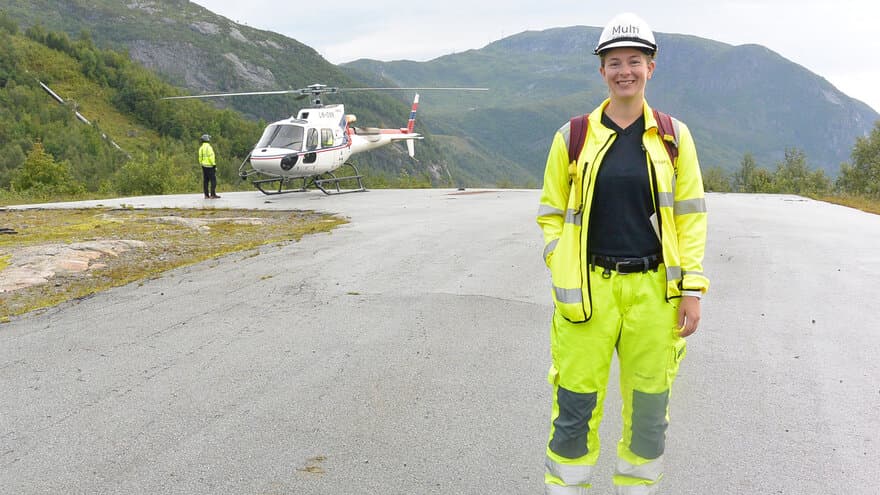Ingeborg and Kristin are both employees at Multiconsult, were they get to work on renewable energy projects, promoting sustainable and responsible use of our natural resources.
- Names: Ingeborg Fjeldberg (32), Kristin Pedersen (35)
- Study program: Landscape Architecture for Global Sustainability
- Employer: Multiconsult (for both)
- Completed studies: Ingeborg in March 2023, Kristin in June 2022
Read more about Landscape Architecture for Global Sustainability
Tell us about your job
As employees of the Natural Resources department in Multiconsult, we work on renewable energy projects, in areas like water, wind, and solar power. This means that we often are dealing with remote and mountainous parts of the country. We conduct research and prepare reports on the potential impact of these projects on the environment.
Our work goal is to promote sustainable and responsible use of the earth's natural resources, while also preserving the integrity of the ecosystems that depend on them.
Examples of issues we are dealing with is the visibility of structures for wind power. How can one build these turbines in a way that minimizes their impact on the surrounding landscape. They are usually visible from a distance up to 40 kilometers. This involves careful consideration of many factors, like the topography and vegetation of the area.
With waterpower the focus is on building dams that are adapted to the terrain, including storage facilities, placement of tunnels and deposition of earth masses. We are also considering how the vegetation will rehabilitate after a construction has been set up. This involves preserving the natural features of the landscape and taking into account the needs of local wildlife and other organisms.
For other projects we are involved with restoration and rehabilitation efforts, like restoring former shooting ranges, opening streams and creeks, and restoring construction areas.
Projects in the Natural Resources department take place in various parts of the world, including Europe, Africa, and Asia.
Tell us about your background
Kristin: For seven years I worked on the installation of green roofs, and I also hold a Master's degree in Agricology from NMBU. I’ve studied horticulture and agriculture in the United States.
Ingeborg: I have a background in graphic design and sociology, which admittedly is an unusual combination. However, both fields are relevant for sustainable landscape architecture. I also hold a bachelor’s degree in landscape planning and architecture.
Why did you choose NMBU?
Ingeborg was attracted to the program because of how it provides a bigger picture on landscape architecture, connecting it with of sustainability and other fields. She wanted to be able to positively influence the planning process with sustainability perspectives.
Kristin’s experience and work from designing green roofs introduced her to solutions that can drive the green transitions, and wanted to expand her knowledge and skills, as well as to be able to work with a broader range of sustainable solutions.
How do you apply your knowledge from your education in your job?
Kristin explains that in her studies, each student has a case study for the semester that involves planning for a complex and large landscape area, like a refugee city or a flood-prone area. Your teacher will closely follow you up your progression on the case. These case studies are very relevant for work life, as you will be trained in considering a wide range of factors. In work life you’ll work with experts in fields like hydrology, biology, ecology, outdoor activities, geology, flood risk, nature conservation, as well as working with technical engineers.
Ingeborg: I also want to highlight the importance of electives available. For me, it allowed me to specialize in hydrology, which is relevant in her current job. When it comes to design, even though it's not currently a big part of our job, it’s important to have some skills in this area. In some projects, we are required to come up with design proposals, for example when visualizing how a dam will be placed in a given natural environment.
How did you land your jobs?
Kristin: I simply applied and got this job the same semester as I wrote my master’s thesis.
Ingeborg: I happened to meet with Multiconsult and talked about my then ongoing master’s thesis. Then, after some time, they reached out and asked me to visit them for a job interview.
What are the most important things you learned through studies?
The most important thing we learned as students, was to develop critical thinking skills and learn how to work independently, and how to acquire new knowledge. Even though you may not necessarily become an expert on a particular topic, you will know how to dig deeper when needed. This has provided us with a solid foundation for lifelong learning.
Ingeborg: I also went on exchange studies in Uppsala, Sweden, and highly recommends this. A general advice is to take advantage of all the opportunities that student life provides you.
